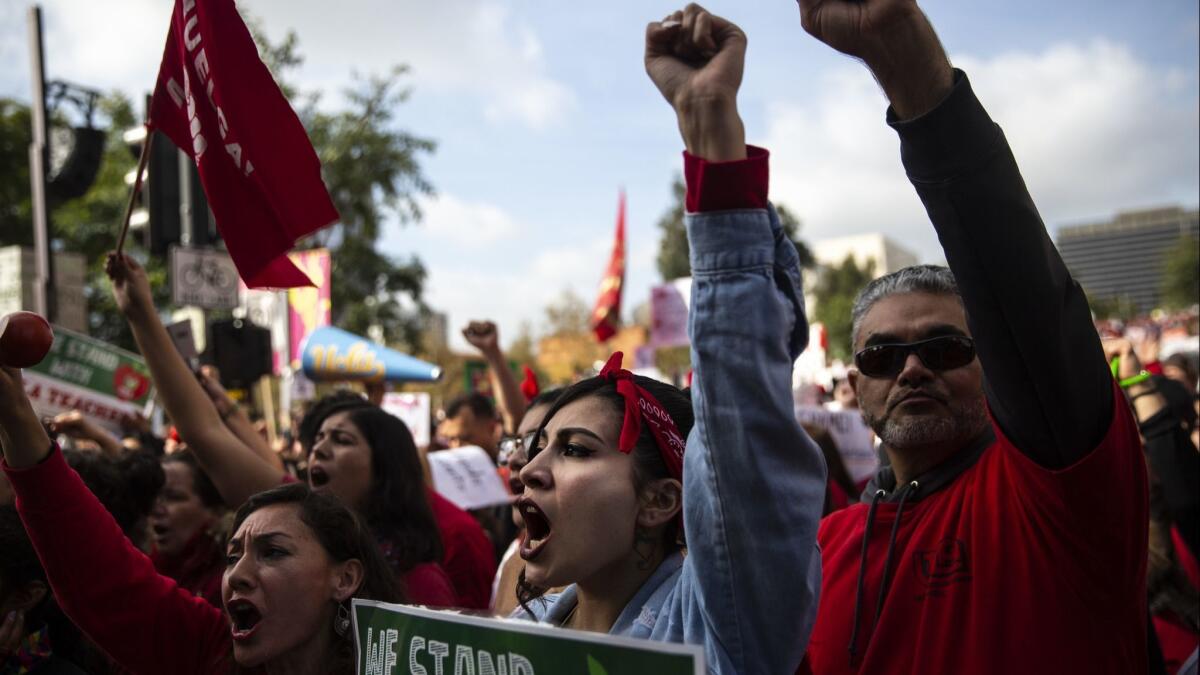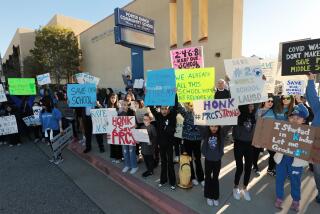Editorial: No matter how the teachers’ strike ends, LAUSD’s long-term problems aren’t going away

The teachers strike will, of course, end eventually. But no matter how it is concluded, the long-term problems facing the Los Angeles Unified School District will not be miraculously resolved. The reopening of schools, whether next week or next month, shouldn’t end the discussion of the serious issues highlighted by the strike.
The heightened awareness of too-large class sizes, understaffed schools, frustrated teachers and unsustainable pension liabilities must not be allowed to fade away. Those issues, along with the declining enrollment at L.A. Unified and the long-term effect of charter schools on the traditional public school system, should propel change at both the state and local level.
The need for more money is undeniable. California is among the bottom 10 states nationwide when it comes to per-pupil spending; it spends half of what New York does when the cost of living is factored in, according to an analysis by Education Week. Its academic performance reflects that. The state is below average in practically everything, according to the National Assessment of Educational Progress, and it has been for years. Fourth grade science? California is third from the bottom. Fourth grade reading? Eighth from the bottom.
But any discussion of the future also has to include this uncomfortable truth: Money is not the sole solution to the problems at L.A. Unified or the rest of the state. How it is spent is just as important as how much is spent. Consider, for instance, that when adjusted for the cost of living, New York spends far more per student than many states that outperform it on national assessments.
California taxpayers would be more willing to pay additional money for schools if they felt it would be spent well.
One obvious item that needs addressing is class size, which must be reduced so teachers can pay more attention to each student and classes are quieter, less stressed and disrupted. California has one of the lowest teacher-to-student ratios in the country, consistently ranking fourth from the bottom.
But research has shown that smaller classes on their own don’t necessarily lead to greater academic achievement. Some grades seem to do better with fewer students per class, others less so. Tennessee made a big splash when it drastically reduced class sizes in primary grades, resulting in improved student performance. Wisconsin and California followed suit, but while Wisconsin’s effort resulted in gains, California’s was less successful. Education experts have theorized that this had a lot to do with a too-fast roll-out at a moment when there weren’t nearly enough qualified teachers for all the new openings.
If L.A. Unified were to give in to all the union’s demands and engage in a massive hiring spree right now, it would almost certainly run into the same problem. The state already has significant shortages of qualified teachers available for hire. The same could prove true for counselors, nurses and qualified school librarians.
Even the issue of teacher pay is more complicated than it seems. Of course most right-thinking people believe teachers should be well-compensated, given how important a role they play in society. But California is not quite as bad on this score as many seem to think. The average teacher salary is about $75,000 (at L.A. Unified and statewide) for a 10-month-a-year job, putting California at about the midpoint nationally on salary when adjusted for cost of living. That’s not stellar, but not nearly as low as it ranks on class size or overall spending.
Enter the Fray: First takes on the news of the minute »
One thing the state should seriously consider is whether it makes sense to take cost of living into account in determining how much money school districts receive per pupil. L.A. County homes sell for more than twice the price of those in neighboring Kern County.
If the state can come up with significant new money, it should be earmarked for things that will help students most: well-planned smaller class sizes, strong counseling programs and fair salaries for teachers that allow them to live where they work, rather than continuing the unsustainable level of retiree benefits. California taxpayers would be more willing to pay additional money for schools if they felt it would be spent well.
Similarly, Los Angeles Unified voters will probably face a ballot measure in 2020 for a parcel tax; we hope that measure will spell out how the money would be spent, and that a strong citizens oversight board would be created to make sure the dollars get to the right places. Spend more, for sure. But spend smart.
Follow the Opinion section on Twitter @latimesopinion and Facebook
More to Read
A cure for the common opinion
Get thought-provoking perspectives with our weekly newsletter.
You may occasionally receive promotional content from the Los Angeles Times.






